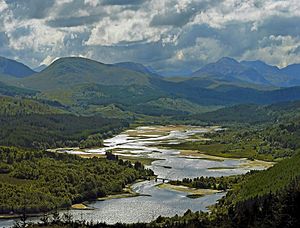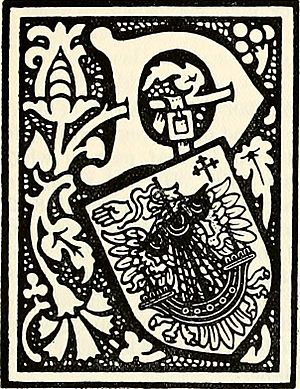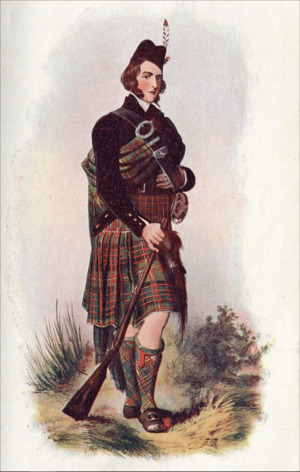Clan MacDonell of Glengarry facts for kids
Quick facts for kids MacDonell of Glengarry |
|||
|---|---|---|---|
| Clann Dòmhnaill Ghlinne Garaidh | |||

Crest: A raven Proper perching on a rock Azure
|
|||
| Motto | Creagan an Fhitich (The Rock of the Raven) | ||
| Slogan | Per mare per terras (By sea and by land) | ||
| Profile | |||
| Region | Scottish Highlands | ||
| District | Ross-shire Inverness-shire |
||
| Plant badge | Common Heath | ||
| Pipe music | Glengarry’s March | ||
| Chief | |||
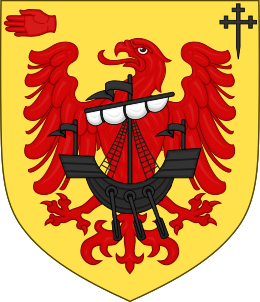 |
|||
| Colin Patrick MacDonell of Glengarry | |||
| The 24th Chief of Glengarry (Mac Mhic Alasdair) | |||
| Historic seat | Strome Castle Invergarry Castle |
||
|
|||
|
|||
|
|||
|
|||
The Clan MacDonell of Glengarry is a famous Scottish clan. It's a part of the much larger Clan Donald. The clan gets its name from the River Garry in the Scottish Highlands. This river flows through Loch Garry and joins the Great Glen.
The MacDonells of Glengarry have a long history. They once owned lands in Ross-shire and Lochaber. Sometimes, they had arguments over land with other clans, like Clan Mackenzie. The clan was a strong supporter of the House of Stuart during the Jacobite rebellions. This meant they wanted the Stuart family to be kings of Scotland and Britain. After these rebellions, many clan members suffered during the Highland Clearances. This was a time when many people were forced to leave their homes. Because of this, many MacDonells moved to other parts of the world, especially North America.
Today, Clan MacDonell of Glengarry has a chief who is officially recognized. This recognition comes from the Court of the Lord Lyon. This court is the main authority for heraldry (coats of arms and clan symbols) in Scotland.
| Top - 0-9 A B C D E F G H I J K L M N O P Q R S T U V W X Y Z |
Discovering the MacDonells of Glengarry
Clan Beginnings
The MacDonells of Glengarry are one of the main branches of Clan Donald. Clan Donald is one of the biggest and most powerful Scottish clans. The clan's story begins with Somerled. He was a strong leader in the 1100s. He was known as "King of the Isles." Somerled built a large kingdom in the islands.
Later, Robert the Bruce, a famous Scottish king, gave land to Aonghus Óg of Islay. This included part of Lochaber. Angus Og's son, John, became the first Lord of the Isles. The MacDonells of Glengarry come from John's first marriage. Their ancestor was Reginald, John's eldest son.
The 1400s: Early Chiefs
Reginald, the first of Clanranald and Glengarry, inherited many lands from his mother. He had five sons. One son, Alan, started the Clan Macdonald of Clanranald. Another son, Donald, became the second chief of Glengarry.
Over time, the MacDonells of Glengarry gained legal ownership of their lands. These lands had been taken by the Scottish Crown. Donald, the second chief, had three sons. His first son, John, died without children. So, his half-brother, Alexander "of the Woods," became the fourth chief. Alexander is often seen as the first true chief of Glengarry. From Alexander, the clan gets its Gaelic name, Mac Mhic Alasdair. This means "son of the son of Alexander."
The 1500s: Battles and Land Disputes

John MacAlister Ranaldsoune, the fifth chief, inherited the Glengarry lands. The clan was closely linked to the MacDonalds of Clanranald. They fought in battles like the Battle of Bloody Bay. John MacAlister was killed by the Frasers of Lovat in 1501. This led to a conflict where the Frasers were defeated. The Glengarry MacDonells then took over the lands of Abertarff.
Alexander Ranaldson, the sixth chief, was known for being rebellious. The Scottish Crown wanted to control the Highlands more. They tried to replace old clan rights with new feudal rules. This meant the Crown became the ultimate owner of the land. Alexander Ranaldson did not accept these changes easily. He supported rebellions against the Crown.
In 1539, Alexander Ranaldson finally received a Crown charter. This gave him legal ownership of Glengarry, Morar, and Strome Castle. However, he continued to support attempts to bring back the Lord of the Isles. He was even imprisoned for a time in Edinburgh. The MacDonells of Glengarry also fought in the Battle of the Shirts. This battle was against Clan Fraser of Lovat. Alexander Ranaldson died in 1590.
Angus MacAlester, the seventh chief, was smart about politics. He used his family connections to get his ancestral lands back in 1574. He also led a raid on MacKenzie lands. The MacDonells took plunder, but the MacKenzies attacked them on their way to the Isle of Skye. Many MacDonells, including Angus MacAlester, were killed.
Donald MacAngus, the eighth chief, became chief in 1576. He was known for being peaceful with his neighbors. However, the Earl of Argyll threatened to invade Glengarry lands. Donald MacAngus asked the Privy Council for help. The Council ordered the Earl of Argyll not to harm Glengarry. They also told other clans to help defend the MacDonells. The Earl of Argyll then stopped his invasion plans.
The 1600s: Conflicts and Castles
The rivalry between the MacDonells of Glengarry and Clan Mackenzie grew stronger in the 1600s. In 1601, Angus, Donald MacAngus's son, attacked MacKenzie lands. This led to the Battle of Morar in 1602. The MacDonells of Glengarry fought against Clan Mackenzie and Clan Ross. After the battle, the MacDonells gave Strome Castle to the Mackenzies. The Mackenzies then destroyed the castle with gunpowder.
The clan soon built Invergarry Castle. It was built on a rock called "Creagan an Fhithich," which means "The Rock of the Raven." This became the clan's motto. The MacDonells also attacked the Mackenzies again. They burned a church in Kilchrist with Mackenzie clansmen inside. A MacDonell bagpiper played a tune called "Kilchrist" during the fire. Later, the Mackenzies got revenge by burning thirty-seven MacDonells alive.
Donald MacAngus was imprisoned for a time for disagreeing with royal policy. But in 1627, Glengarry was made a free barony by the King.
During the Wars of the Three Kingdoms (civil wars in Britain), Donald MacAngus was too old to fight. His son, Aeneas, became the leader. Aeneas was a strong supporter of the King. He fought under Montrose. After the war, Oliver Cromwell took Aeneas's lands. But they were returned after the King came back to power in 1660. Aeneas was given the title Lord MacDonell and Aros.
In 1665, a big fight broke out between the MacDonells and the town of Inverness. It started over a dropped cheese at a fair! The fight quickly became violent, with two people dying. The MacDonells threatened revenge. The case went to the Privy Council. The Council ruled in favor of the MacDonells. Inverness had to pay them a large sum of money. Aeneas died in 1680 without any children to inherit his title.
Ranald, the tenth chief, became chief in 1680. He was an old man. But he led the Catholic Jacobite group during the 1688 Revolution. His son, Alastair Dubh MacDonell, acted as the clan leader. The Scottish Parliament took Glengarry's lands. But the MacDonells still held Invergarry Castle. The clan fought at the Battle of Killiecrankie. By 1691, Invergarry Castle was under attack. The government wanted to make an example of the MacDonells. But they changed their target to the Glencoe MacDonalds. This led to the sad Glencoe Massacre. Ranald died in 1705.
The 1700s: Jacobite Risings
Alastair Dubh MacDonell, the eleventh chief, was a famous warrior. He and his father were among the first Highlanders to join the Jacobite cause. They wanted to bring back James Francis Edward Stuart as king. Alastair Dubh fought in the Jacobite rising of 1715. He joined Viscount Dundee with 300 of his followers. The MacDonells of Glengarry also fought at the Battle of Sheriffmuir. When the chief of Clanranald was hurt, Alastair Dubh encouraged his warriors. He shouted, "Blows today, mourning tomorrow!" Even though it was a victory, it didn't help bring the Stuarts back to the throne. In 1716, James Francis Edward Stuart gave Alastair Dubh the title Lord MacDonell. Alastair Dubh died around 1721.
His son, John, became the twelfth chief. John made a "Bond of Friendship" with Patrick Grant of Glenmoriston. This agreement helped keep peace between their clans. John did not actively join the Jacobite rising of 1745. However, Glengarry's Regiment fought in the uprising. They were led by Aeneas, Alastair Dubh's second son. The regiment fought in many battles, including the Highbridge Skirmish and the Battle of Prestonpans. Aeneas was accidentally shot after the Battle of Falkirk. He died three days later.
Donald MacDonnell of Lochgarry then led the Glengarry regiment. They fought at the Battle of Culloden in April 1746. The Glengarry regiment was very large, with 530 men. After their defeat at Culloden, the regiment broke up. Charles Edward Stuart (Bonnie Prince Charlie) visited Invergarry Castle. But soon after, the castle was burned down by the British army. Aeneas's older brother, Alastair Ruadh MacDonnell, was captured in 1745. He was held in the Tower of London. He was later released and became a spy for the British government.
The 1800s to Today
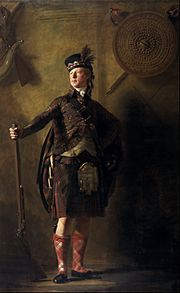
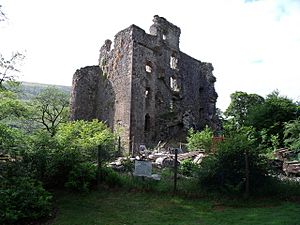
The Highland Clearances in the early 1800s forced many MacDonells of Glengarry to leave their homes. Most of them moved to Glengarry County, Ontario and parts of Nova Scotia in Canada. The fifteenth chief, Alexander Ranaldson MacDonell of Glengarry, ordered many of these evictions. He was known for being proud and showy. He even inspired a character in a famous novel by Walter Scott.
In 1815, Glengarry started the Society of True Highlanders. This showed the strong Highland pride at the time. He was also involved in arguments about who should go first during King George IV's visit to Scotland in 1822. This visit helped make tartans and traditional Highland dress very popular.
Fr. Alexander MacDonell (1762–1840) was a Catholic priest. He helped create the Glengarry Fencibles, a military regiment, in 1794. He later moved to Canada with his clansmen. He helped bring back the regiment for the War of 1812. He became the first Catholic Bishop of Kingston in Canada. Sir James MacDonell, a brother of the fourteenth chief, was a hero at the Battle of Waterloo during the Napoleonic Wars. He was called "the bravest man in the British Army."
Aneas Ranaldson, the sixteenth chief, sold his estate in 1840. He and many of his clan moved to Australia. This was a sad event for many, as it meant the clan was leaving its old lands. Aneas Ranaldson later returned to Scotland and died in 1851.
The seventeenth chief, Alexander Ranaldson, also returned from Australia. But he later sold his estate and moved to New Zealand. He died there in 1862. His younger brother, Charles Ranaldson, became the eighteenth chief. But he died on his way home from New Zealand. This meant the main line of chiefs from the eleventh chief ended. However, a distant relative, Aneas Ranald, became the nineteenth chief. This kept the clan's chief line going.
Later chiefs included Aeneas Ranald Wesdrop, the twentieth chief. He was involved in business. Aeneas Ranald MacDonell, the twenty-first chief, fought in World War I. Aneas Ranald Donald was the twenty-second chief, and his brother, Aeneas Ranald Euan MacDonell, was the twenty-third chief.
The current chief is Colin Patrick MacDonell. He is the twenty-fourth Chief of Glengarry.
Clan Castles
The MacDonells of Glengarry have owned several important castles:
- Invergarry Castle was the main home of Clan MacDonell of Glengarry. It stands on a rock called Cregan an Fhithich, which means "The rock of the raven." The clan built the castle in 1602. It was attacked several times. In 1715, Alasdair Dubh of Glengarry took it back during the Jacobite Uprising. But it was recaptured in 1716. The MacDonells took it back again in 1731. During the Jacobite rising of 1745, Charles Edward Stuart visited the castle. But after the rebellion failed in 1746, the British government burned it down.
- Strome Castle was the clan's original historic castle. It was built in 1472. King James V of Scotland gave the castle to Clan MacDonell of Glengarry in 1539. In the 1600s, Clan Mackenzie attacked and surrounded the castle. After the MacDonells surrendered, the Mackenzies blew up Strome Castle with gunpowder.
Clan Symbols
- Clan Chief: The chiefs of Clan MacDonell of Glengarry are traditionally called "Mac Mhic Alasdair." The current chief is Colin Patrick MacDonell of Glengarry. He is the 24th chief.
- Chief's Coat of Arms: The chief's coat of arms has a golden shield with a red eagle. It also shows a ship and a hand. Above the shield is a helmet with a raven on a blue rock. The motto "CRAGAN AN FHITICH" means "The Rock of the Raven." Below the shield are two bears. The motto "PER MARE PER TERRAS" means "By sea and by land."
- Clan Member's Crest Badge: Clan members can wear a crest badge. It has a raven on a blue rock. The motto inside the badge is CREAGAN AN FHITICH.
- Clan Plant Badge: The plant badge for the clan is common heather. This plant is also used by other MacDonald clans.
- Pipe Music: The clan's bagpipe tune is Spaidsearachd Mhic Mhic Alasdair. This means "Glengarry's March." Another tune, "Kilchrist," is also linked to the clan.
- Gaelic Name: The clan's Gaelic name is Clann Dòmhnaill Ghlinne Garaidh.
Clan Tartan
| Tartan image | Notes |
|---|---|
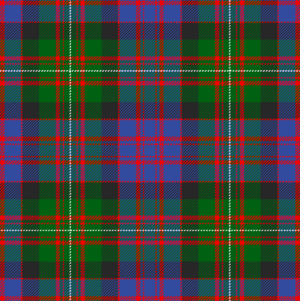 |
This tartan was officially registered for Clan MacDonell of Glengarry. There is an old sample from 1815–16. |
See also
- Lord MacDonell, a special title given by the Jacobite kings.
- Highland Clearances, a time when many people had to leave their homes in Scotland.
- MacDonell, other things named MacDonell on Wikipedia.
- Chiefs of Clan MacDonell of Glengarry, a list of the clan's leaders.


